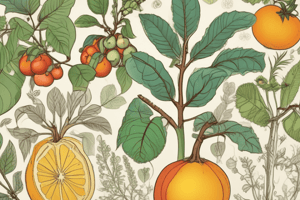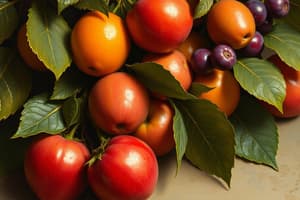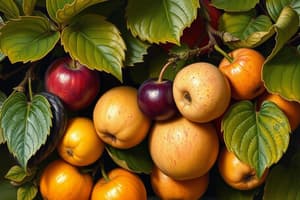Podcast
Questions and Answers
What temperature was used to dry the butter paper bags containing the powdered samples?
What temperature was used to dry the butter paper bags containing the powdered samples?
- 70 !C
- 75 !C (correct)
- 50 !C
- 65 !C
The endocarp of a tomato fruit is the outermost layer.
The endocarp of a tomato fruit is the outermost layer.
False (B)
What instrument was used for estimating mineral nutrients?
What instrument was used for estimating mineral nutrients?
Atomic absorption spectrophotometer
The contents of the nutrient analysis were expressed in mg g-1 dry weight (DW) for ____ and in micrograms per gram DW for ____.
The contents of the nutrient analysis were expressed in mg g-1 dry weight (DW) for ____ and in micrograms per gram DW for ____.
Which layer of the fruit is described as 'berdasarkan pencaran' in the provided content?
Which layer of the fruit is described as 'berdasarkan pencaran' in the provided content?
Match the following fruit types with their descriptions:
Match the following fruit types with their descriptions:
The mesocarp is the outer layer of a tomato fruit.
The mesocarp is the outer layer of a tomato fruit.
What is the general method used for storing powdered samples until further use?
What is the general method used for storing powdered samples until further use?
What are the major physiological events that occur during fruit ripening?
What are the major physiological events that occur during fruit ripening?
Ripening of fruit is indicated with solid lines after the climacteric phase.
Ripening of fruit is indicated with solid lines after the climacteric phase.
What does qRT-PCR stand for?
What does qRT-PCR stand for?
The fruit becomes easier to digest and more susceptible to ______ by microbes during the ripening process.
The fruit becomes easier to digest and more susceptible to ______ by microbes during the ripening process.
Match the stages of apple fruit development with their respective days after anthesis (DAA):
Match the stages of apple fruit development with their respective days after anthesis (DAA):
Which enzyme is considered a non-pectolytic enzyme?
Which enzyme is considered a non-pectolytic enzyme?
Non-climacteric fruits exhibit a rapid increase in respiration rate during ripening.
Non-climacteric fruits exhibit a rapid increase in respiration rate during ripening.
What factors change as fruit ripens?
What factors change as fruit ripens?
The structure and composition of ripe fruit remain unchanged compared to unripe fruit.
The structure and composition of ripe fruit remain unchanged compared to unripe fruit.
What phenomenon does exogenous ethylene treatment induce in mature climacteric fruit?
What phenomenon does exogenous ethylene treatment induce in mature climacteric fruit?
In the maturation of non-climacteric fruits, the respiration rate typically _______ observed.
In the maturation of non-climacteric fruits, the respiration rate typically _______ observed.
What is the role of housekeeping genes in fruit development studies?
What is the role of housekeeping genes in fruit development studies?
What is the effect of exogenous ethylene on respiration rate?
What is the effect of exogenous ethylene on respiration rate?
Endogenous ethylene production is not triggered at the pre-climacteric stage.
Endogenous ethylene production is not triggered at the pre-climacteric stage.
Match the following statements with their corresponding effects:
Match the following statements with their corresponding effects:
An increase in respiration rate is observed in ______ fruits, while non-climacteric fruits show no such increase.
An increase in respiration rate is observed in ______ fruits, while non-climacteric fruits show no such increase.
What is a primary factor that influences fruit size?
What is a primary factor that influences fruit size?
Removing excess fruits at an early stage of development allows remaining fruits to grow larger.
Removing excess fruits at an early stage of development allows remaining fruits to grow larger.
What role do leaves play in the growth of fruit?
What role do leaves play in the growth of fruit?
In the case of apples, removing excessive _____ can enhance the growth of the remaining fruit.
In the case of apples, removing excessive _____ can enhance the growth of the remaining fruit.
Match the following terms with their descriptions:
Match the following terms with their descriptions:
What is a consequence of having too many fruits and too few leaves?
What is a consequence of having too many fruits and too few leaves?
It is possible for an apple to grow as large as a watermelon by just removing other fruits.
It is possible for an apple to grow as large as a watermelon by just removing other fruits.
What happens to the seeds within a fruit during its development?
What happens to the seeds within a fruit during its development?
Which hormone is primarily involved in seed development?
Which hormone is primarily involved in seed development?
Auxin has no role in embryo growth.
Auxin has no role in embryo growth.
What is the effect of gibberellin-deficient mutants in pea?
What is the effect of gibberellin-deficient mutants in pea?
Gibberellins were originally thought to play a __________ role in seed development.
Gibberellins were originally thought to play a __________ role in seed development.
What influences the final seed size?
What influences the final seed size?
What is IAA an abbreviation for?
What is IAA an abbreviation for?
Match the following hormones to their functions:
Match the following hormones to their functions:
Free and conjugated forms of __________ stimulate seed development.
Free and conjugated forms of __________ stimulate seed development.
What role does the 'ghost' play in plant growth according to the findings?
What role does the 'ghost' play in plant growth according to the findings?
The insertion of FveAGL80 into the JH4 vector was not necessary for the experiment.
The insertion of FveAGL80 into the JH4 vector was not necessary for the experiment.
What technique was used to analyze the fertilized seeds from F2 plants?
What technique was used to analyze the fertilized seeds from F2 plants?
The gRNA sequence necessary to avoid impacts of parental imprinting is _____
The gRNA sequence necessary to avoid impacts of parental imprinting is _____
Which method was used to confirm the editing of genomic sequences?
Which method was used to confirm the editing of genomic sequences?
What major challenge is mentioned regarding dissecting seeds of other fruit types like tomato?
What major challenge is mentioned regarding dissecting seeds of other fruit types like tomato?
Match the following processes with their respective roles:
Match the following processes with their respective roles:
What conclusion about the role of ghosts does this study draw?
What conclusion about the role of ghosts does this study draw?
Flashcards
Exocarp
Exocarp
The outermost layer of a fruit.
Mesocarp
Mesocarp
The middle layer of a fruit, often the fleshy part.
Endocarp
Endocarp
The innermost layer of a fruit, often hard and surrounding the seeds.
Berry
Berry
Signup and view all the flashcards
Drupe
Drupe
Signup and view all the flashcards
Nut
Nut
Signup and view all the flashcards
Oven Drying
Oven Drying
Signup and view all the flashcards
Atomic Absorption Spectrophotometer
Atomic Absorption Spectrophotometer
Signup and view all the flashcards
Fruit Ripening
Fruit Ripening
Signup and view all the flashcards
Fruit Aroma Production
Fruit Aroma Production
Signup and view all the flashcards
Changes in Fruit Composition
Changes in Fruit Composition
Signup and view all the flashcards
Climacteric
Climacteric
Signup and view all the flashcards
Pre-Climacteric
Pre-Climacteric
Signup and view all the flashcards
Gene Expression Analysis
Gene Expression Analysis
Signup and view all the flashcards
Quantitative Reverse Transcription PCR (qRT-PCR)
Quantitative Reverse Transcription PCR (qRT-PCR)
Signup and view all the flashcards
Regulated Genes
Regulated Genes
Signup and view all the flashcards
Non-pectolytic enzymes
Non-pectolytic enzymes
Signup and view all the flashcards
Respiration rate
Respiration rate
Signup and view all the flashcards
Effect of Exogenous Ethylene Treatment
Effect of Exogenous Ethylene Treatment
Signup and view all the flashcards
Climacteric stage
Climacteric stage
Signup and view all the flashcards
Climacteric fruits
Climacteric fruits
Signup and view all the flashcards
Non-climacteric fruits
Non-climacteric fruits
Signup and view all the flashcards
Maturation and ripening in non-climacteric fruits
Maturation and ripening in non-climacteric fruits
Signup and view all the flashcards
Endogenous Ethylene Production
Endogenous Ethylene Production
Signup and view all the flashcards
Seed Number and Distribution
Seed Number and Distribution
Signup and view all the flashcards
Auxin (IAA)
Auxin (IAA)
Signup and view all the flashcards
Gibberellins
Gibberellins
Signup and view all the flashcards
Pericarp
Pericarp
Signup and view all the flashcards
Receptacle
Receptacle
Signup and view all the flashcards
Auxin Gradient in Embryo Development
Auxin Gradient in Embryo Development
Signup and view all the flashcards
Free and Conjugated IAA
Free and Conjugated IAA
Signup and view all the flashcards
IAA Importance in Early Fruit Development
IAA Importance in Early Fruit Development
Signup and view all the flashcards
Cellular Size Limit
Cellular Size Limit
Signup and view all the flashcards
Fruit Development
Fruit Development
Signup and view all the flashcards
Leaves and Fruit Size
Leaves and Fruit Size
Signup and view all the flashcards
Leaf to Fruit Ratio
Leaf to Fruit Ratio
Signup and view all the flashcards
Competition for Resources
Competition for Resources
Signup and view all the flashcards
Fruit Thinning
Fruit Thinning
Signup and view all the flashcards
Genetic Limits
Genetic Limits
Signup and view all the flashcards
Leaf Waste
Leaf Waste
Signup and view all the flashcards
Confirm Editing by PCR and Sequencing
Confirm Editing by PCR and Sequencing
Signup and view all the flashcards
CRISPR-Cas9 Technology
CRISPR-Cas9 Technology
Signup and view all the flashcards
Ghost
Ghost
Signup and view all the flashcards
Homozygous Lines
Homozygous Lines
Signup and view all the flashcards
Binary Vector
Binary Vector
Signup and view all the flashcards
Role of Ghost in GA Biosynthesis
Role of Ghost in GA Biosynthesis
Signup and view all the flashcards
Study Notes
Learning Outcomes
- Students will be able to describe the process of fruit formation and maturation.
- Students will be able to compare diverse fruit structures and types.
What is a Fruit?
- Botanically, a fruit is one or more ovaries, along with associated tissues, that have matured and ripened.
- Horticulturally, a fruit is one or more mature ovaries plus accessory tissues; possessing high sugar content and typically eaten as dessert, in salads, or snacks.
Fruit Structure and Development
- Fruits develop as a result of pollination and/or fertilization.
- Fruit is an accessory reproductive structure in flowering plants (angiosperms).
- It contains seeds.
Fruit Classification
- Simple Fruit: Develops from a single pistil (e.g., pea, tomato, apple, cucumber).
- Aggregate Fruit: Develops from multiple, separate carpels of a single flower (e.g., strawberry, raspberry).
- Multiple Fruit: Develops from multiple carpels of multiple flowers within an inflorescence (e.g., pineapple, fig).
- Accessory Fruit: Develops from tissues other than the ovary (e.g., apple, pear).
Factors Influencing Fruit Structure
- Flower structure influences fruit structure.
- Ovary position, number of ovaries.
Fruit Maturation
- Fruit maturation is typically characterized by changes in color, texture, flavor, and aroma. These changes are due to increases in the production of volatile compounds, associated with fruit ripening.
- This occurs as the fruit ripens and the starch is converted to sugar.
Studying That Suits You
Use AI to generate personalized quizzes and flashcards to suit your learning preferences.
Related Documents
Description
Test your knowledge on fruit biology, nutrient analysis, and associated processes. This quiz covers topics such as fruit ripening, nutrient estimation, and the anatomy of fruits like tomatoes. Ideal for students in biology or agricultural sciences.



